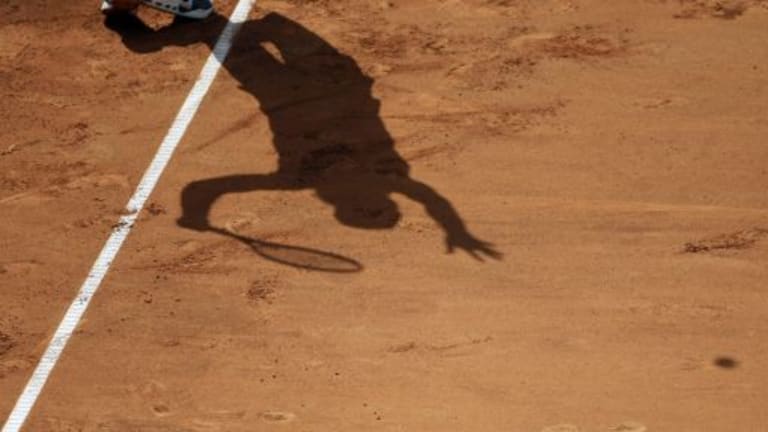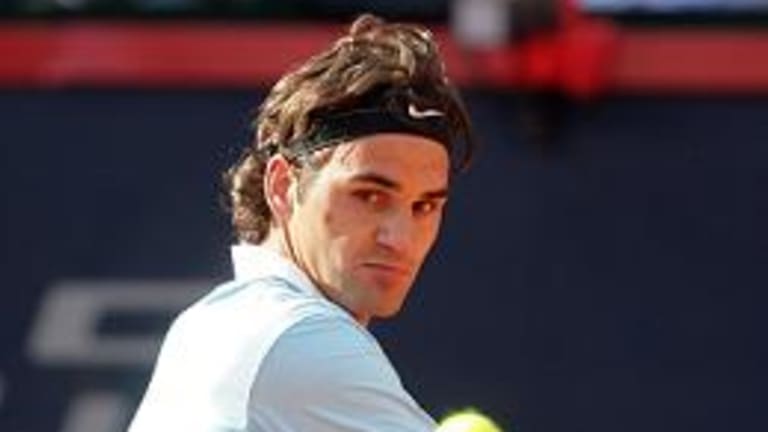Like most of you, I've been contemplating the recent matches in Hamburg, specifically the Roger Federer vs. Rafael Nadal final, which puts me in danger of being a two-channel receiver in a 750-channel digital-cable world. Sure, there are plenty of other things to write about, and I hope the subjects of my recent posts showed it. But sometimes Roger and Rafa are, like death and taxes (care to assign roles?), impossible to avoid.
In general, I have a perverse reaction to the clay-court season, and lest you think it's yet another of my terrible, troglodyte biases, it's no different from my reaction to the U.S. Open hard court series. Ironically, these "road to" tournaments are warm-ups; significant, remunerative, eagerly and closely watched and exciting, but still warm-ups. Roger Federer fans might call them "information gathering" opportunities; Rafael Nadal fans might call them chances to make hay while the sun shines. I call them comfort sport for the needy - it's a long stretch between the Australian Open and Paris!
But the fact that TMF and Jet Boy are never more dominant fixtures in the tennis imagination than during May is telling. I'm keeping my powder dry, but they clearly are not. And while Novak Djokovic's bombastic statement in Rome, and the earlier antics of Radek Stepanek and Juan Carlos Ferrero certainly were eye-catching, I'm not sure they were over-freighted with significance (that's always the problem with "road to" events; what if you arrive at the end of that road after an epic journey only to discover that they lost your hotel reservations?) In fact, unless you buy a lot of the armchair hokum, or passionately support the wealth-distribution scheme that is the ATP Tour/calendar, the most intriguing and lasting outcome of the clay-court season comes down to this: it provides valuable filler for the greatest value-added feature in tennis - rivalry.
I started thinking along those lines after writing my most recent ESPN post on Monday morning, in which I listed the male and female winners on spring clay-court circuit. The women's champion's roll was a hodge-podge that featured exactly one Top Five player (Jelena Jankovic) and no Grand Slam title winners. Among the men, the blue-chip rogue's gallery was led by Federer, Nadal and Djokovic. Ironically, the ancient refrain that women's tennis lacks depth has been demolished, although not exactly the way everyone hoped (by competitive parity). The impression we're left with is that the very concept of a meaningful WTA Tour is hollow.
By contrast, the ubiquity of the three men mentioned above (the "trivarlry", as someone has described it) suggests that the men's game is being both dominated and chugging along under a great head of steam. In other words, maybe Pete Sampras was right when, before Roger and Rafael discovered each other, he had a one word answer for what tennis needs: "rivalry." It has that now - boy, does it ever.
In pinning TMF to the mat in Hamburg, Nadal improved his head-to-head lead to 10-6 - not exactly Sampras vs. Andre Agassi territory (Sampras led their final H2H, 20-14) but getting there, given the age factors. Projected outward, Nadal might end up with a similar margin, but that's where stats and precentages can fail you. The intensity of the rivalry has increased in recent years. Between Miami of 2004 and Roland Garros of 2006, Nadal won 6 of 7 matches and, at one point, five in a row.
But since the start of 2007, Federer has closed the gap (just writing the words feels, well, weird). Nadal has his nose out in front, but only by 4-3 mark. That e number is deceptive, because Federer gets into position to play Nadal on clay more frequently than Nadal can slash his way to finals on harder surfaces, especially indoor carpet or outdoor hard. But let's leave the "fair world" debate for another time. Federer has a 5-2 lead on surfaces other than clay, and Nadal hasn't take a match on a surface other than clay since very early in 2006 (at Dubai).
These numbers underscore the importance of surface, which is nothing new when it comes to classic rivalries. Andre never could beat Pete at Wimbledon or the U.S. Open, but he won every battle they joined at the other two majors. Incidentally, Australian hard (back then, it was Rebound Ace) served Agassi much like grass serves Nadal. Is it any less surprising that Pete Sampras neither liked nor performed particularly well - relatively speaking, anyway - on Rebound Ace than that Nadal has turned into such a grass-stained warrior? Rivalries are partly turf wars, and Nadal's most novel achievement has to be put in terms of an oxymoron to be fully appreciated: He's engaged in a heated rivalry with a man who's been accused of utterly dominating his sport. As they say, Hey, Howdid he do that?
He did it by coming to grips with the grass court game, is how. And while Jet Boy hasn't beaten Federer on grass, it's those two consecutive Wimbledon finals (2006 and '07) that really lifted the rivalry to a higher plane. Were it not for those battles, especially the most recent, riveting one, you could argue that Nadal was nothing more (or less) than an accomplished guerrilla warrior, harassing the equivalent of a tennis superpower. The situation might have grown tedious for everyone but Nadal fanatics. So while Nadal may not take great comfort out of his two failed challenges at Wimbledon, we can.
Among other things, this state of affairs underscores a unique and glorious aspect of tennis: the importance of surface. This is not something to be taken lightly, because it's surface - perhaps surface only - that prevents tennis from becoming too much of a sporting poster-child for the worst elements of what can loosely be called globalization - uniformity, conformity, a depressing sameness to tennis courts, to match what already is, to me, anyway, a depressing sameness of indoor venues, the players dress (thanks, Nike, Adidas, et al!!) and public personae and, to an increasing degree, their technique and style. Is there a person on this earth more "international" by the most common standards than Roger Federer (if there is, the person's name ends in "vic" - and her first name isn't Novak).
This multi-surface tradition in tennis is both unique in pro sports and by no means forced on the game. In baseball, watering down the infield (to slow the ball) leaves a team open to strident accusations of Belichikism, even though the ploy doesn't come close to affecting a baseball the way different court surfaces affect tennis balls, or shots. When was the last time you saw a basketball court that looked significantly different from any other one? Or saw an NBA game played - yikes! - outdoors, under lights with genuine moths zipping around, much like they do in the vast majority of places where amateurs play the game. Charlie Passarell and Ray Moore, the masterminds of Indian Wells, are promoting an exhibition NBA game at the Indian Wells Tennis Garden this fall. A few weeks ago Charlie told me, "The most surprising thing was the reaction of the players. They were ecstatic, they said they couldn't want to play under those conditions."
Lingering provincialism, as in the French Open's decision to retain a clay surface at a time (the late 1970s) when the survival of a relevant clay-court game was by no means a given, has been a cornucopia, and one element spilling out of it is the Federer-Nadal rivalry. So while I'm still trying to keep my powder dry for Roland Garros, here are a few things I've seen along the red-dirt road: The rivalry, at least on clay, has been reduced and simmered and further boiled down and may finally have yielded up its essence. It turns out to be an element amusingly like the one that dominates the battle between a couple of 3.0 slashers down at the public high school's courts. Who's going to get to the backhand? It's almost embarrassingly simple, but I'll repeat it anyway: Who's going to get to the backhand? If Federer can find Nadal's backhand, all other things being equal, he's got a shot. But if Nadal can make that corner inaccessible, forget about it. Game over.

